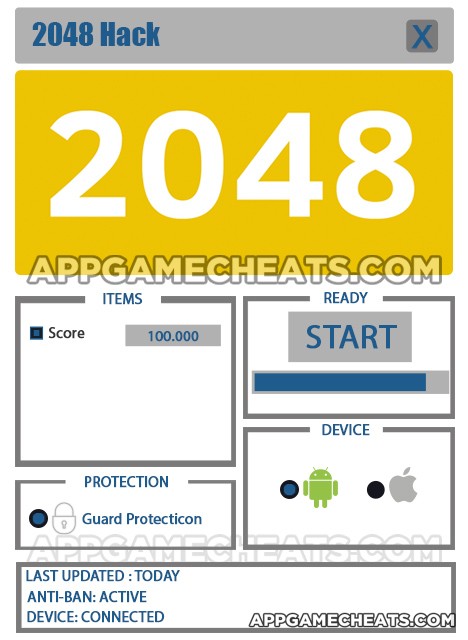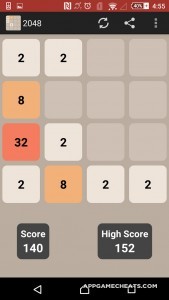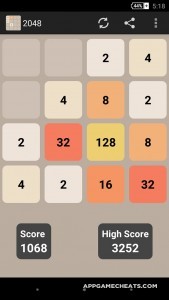

Today we are up with a game that can be your favorite boring time killer if you are into puzzle games. This single-player tiles sliding puzzle game was originally developed by an Italian teenager web-developer Gabriele Cirulli, as a weekend-project. He was self-challenging himself that if he could develop a clone of the games like Veewo Studios’ 1024 & Sami Romdhana’s 2048, which are also a tile-sliding games.
He built the game from scratch so that there won’t be any coding copyright issues, and name of this game is also 2048, and is very similar to ‘Threes!’, which also belongs to the same tile-sliding puzzle-game category released few months prior to 2048.
Do you want to unlock a high score in 2048 with a click of a button? Download our free 2048 hack tool now, straight from our site. This tool will easily and quickly allow you to get a high score.
The 2048 hack tool is super simple to use. See the image below? This is what it looks like. Just download it and click the button that says “start.” Enter the score you want.

Download our 2048 hack from our website. It’ll take 30 seconds for the download to finish, depending on your Internet connection. Then, you’ll need to install the hack. This is an extra 30 seconds. The high score will be set to fill in automatically.
Click the big “start” button to begin the hack. After the hack has finished, which should only take about 30 seconds, open the app on your device like normal. The high score will be ready. Enjoy!
This, a 4×4 grid containing multiples of 2 puzzle-game, was originally launched as a browser game which was introduced for iOS and Android devices after some time, the same path that many other games followed in recent past. Cirulli was in all-surprise when he got to know that his web-based version of game crossed a ‘4 million visitors’ mark in less than a week time.
Cirulli once said in an interview that he had no intentions to earn from a thing which he didn’t invent. So he released his version of 2048 as a free and open-source game, for both Android and iOS. As this is an open-source, different developers around the world used the code and even enhanced it to build a version of their own with or without any actual difference, and this is the point where Digiplex.in jumps in.
Digiplex.in seized the opportunity, took the original code, kept it light as possible, added few additions like leaderboards and improved touch-screen playability, and released it under their own name. As this version of 2048 has somewhere between ten and fifty millions downloads on Google Play Store only, which is highest for any 2048, and because of that users will find heavy of competition in leaderboards which is a positive thing.
I’ll proceed further after saying that due to much popularity and addictiveness, this game was even deemed as the ‘Candy Crush’ for Maths-geeks by Wall Street Journal, what else is required to prove the greatness of this game!!
Digiplex.in’s version of 2048 is totally vanilla. There isn’t any kind of intro or even a general menu/dashboard. This game will take you straight away towards the grid, and you’ll be welcomed with two simplest tiles of the game, i.e., 2x 2s. One single popup will tell you about the game rules and mechanics. The user has to slide one of the two randomly placed tiles of 2 in a 4×4 grid. The tiles can slide only in horizontal & vertical direction, i.e., no sliding in diagonals. Every tile slides in the direction the slide is made, and the tiles slide in possible direction until they are stopped by another tile or the end of grid.
If two tiles having same number are combined, a new tile will appear with a number that is double of the combined number. For instance, if a tile with number 4 is combined with another tile having the same number, i.e., 4, a new tile with number 8 will appear, and the tiles combined will disappear. A new tile with number 2 appears on a random position simultaneously with every slide.
The goal behind every slide is to make larger numbers, which is not possible all the times. At times, you have to make dummy moves to get a new tile and keep the game going on. The game ends when the matrix of 4×4 completely filled and you are stuck between tiles, i.e., there is no space to make a slide on the grid. Higher-value tiles release a soft glow when made.
There is a scoreboard given in the bottom of the grid where the current score and the highest score are given. The ‘score’ starts from the zero, and ads up a number equal to the new number generated after combining two tiles with the same number. For instance, if 8 and 8 are combined, 16 will be added to the score. The user wins when a tile with the number ‘2048’ appears on the gray matrix, where basically the name of the game is taken from, but it doesn’t it here. The game can be continued beyond 2048 tile to surpass the previous Highest Score.
Towards the right side of the grid, you’ll find a small drop-down menu, and when you open it, you’ll find options including settings. There is an orientation tab. When you open it you will find three options for having orientation what you want. First one is “portrait” which will give you vertical view of the grid but if you find it uncomfortable you can change the orientation to “landscape” which will give a horizontal view of the grid. There is also an option for auto orientation. Moreover there is an option for animation. You can turn it off or on whatever you like. Animation speed can also be controlled. You can adjust it from slow to fast range scale.
There is an undo option given and that’s something which makes this version of 2048 unique. Player is given 5 chances to undo his last move. While you are playing the game and you unintentionally or intentionally made a move that you find wrong move you can undo it. So, it is a kind of lifeline in this game.
The question in everyone’s mind might be: ‘Where does the game end?’ Interestingly, you have choice to select where you want to end your game. In settings menu there is an option by name “Game ends at”. This option gives you chance to select where you want to finish your puzzle. It has three options. First is to end it at when you reach 1024 number. Second one is to end this puzzle when it reaches magic number of 2048.The last option is to keep the game going until you are stuck. In this mode, game will not end at 1024 or 2048 tile. Instead it will keep going until no move will be left, and you might be surprised to know that there are over one hundred thirty thousand possible moves.
This review is based upon 2.6.3 version of 2048. It is only available for Android, i looked around to see if Digiplex.in has released an iOS version but I couldn’t find any. Android 2.3 (gingerbread) is required to run this game, and i believe there hardly might be any device which cannot run this game. 2048 is totally free, there isn’t any kind of in-app purchases, freemiumness, or even ads.
2048 can be synced with Google Play Games and high score will always be retained even if users format their device. There are sixteen achievement are available to give user’s Google Play game profile a tiny boost, and most of the achievements are about reaching a targeted score, for example, four thousand XP for making ten thousand game points.
This game doesn’t feature any in-app purchases or unlockables hence cheats are not required and they aren’t present either, but user can always use some tips to improve their game. The only goal is to achieve the magic number of 2048 by sliding tiles in different directions. Here are some tips which will help you to achieve your goal.

I might not be a puzzle-game lover but I personally found this game very addictive. Its ability to keep the gamer stick with it makes it really a ‘Candy-Crush’ of maths geeks. It keeps the gamer’s mind busy every moment, and never lets gamer get bored. Even its developer Cirulli call it a ‘source of pastime’. Apart from being addictive, it’s a highly mind-boggling stuff. It also helps to freshen-up one’s mind, to keep it active for some really mentally tough jobs.

let’s start with the artwork. Like many other games that are 2048, this one might not be appealing you on artwork’s point of view, but it is a simple game with just good enough artwork so that user can understand things easily, and it isn’t that bad either. Tiles of different numbers has different colours, sliding animations are fluid, and i thinking nothing else was required from a game whose life depends upon the uniqueness of the gameplay only.
Sound department is almost silent, at just a size of fourteen megabytes, I don’t think it will be fair to expect too much from it. Sound is default set to off. After turning it on from option, a popcorn popping sound will be produced on every move, other than this there is nothing, no background soundtracks or anything, and i believe absence of background music is totally debatable as it depends upon the personal preferences of an individual, some might find it annoying while playing whereas some would love playing with it.

The user interface and controls literally feels like the least important part of the game, and they almost don’t even exist. As the source code is same, the gameplay is similar to rest of the 2048s out there is the market, and if I forget for a while that there is other 2048 than this one, it will be one of the best puzzlers that I’ve tried in my life. It’s extremely cute and addictable, and especially being an Engineering student I loved it because it’s finally a puzzle game which isn’t a match-three puzzler.

Coming to its originality part, it’s a bit shameful side of it that it’s not an original stuff in literal sense. As it’s already mentioned in the background portion of this article that this very game is a clone of ‘Threes!’, which was actually developed just a few months earlier. ‘2048’ owes its success to the games like ‘Threes!’, ‘1024’ & ‘2048’ developed by some other gamer earlier. This is the very reason that some gamers who are a bit more conscious about giving credits to the deserving-ones prefer to play the other ‘Original’ version of this 4×4 puzzle-games mentioned earlier.
Ratings:
Artwork: I’ll give 2048 a 6/10 for its artwork. As i’ve mentioned previously, this game is totally vanilla with miniature size and it isn’t aimed to attract users via artwork, but artwork still delivers what it is intended to. Artwork might not be the most hi-fi that i’ve seen yet, but they still are better and simple than many other arcade games.
Music & SFX: I’ll give 2048 a 6/10 for its music & SFX. Music & SFX department literally cease to exist, you’ll only get popcorn popping sound while sliding tiles, other than this there is not even a single beep, which can be a plus point if you like to enjoy game with music, and sometimes only that popcorn popping sound feels enough.
Story & Originality: I’ll give this game another 5/10 for its story & originality. There isn’t any story line and as far as its originality is concerned, it’s the weakest point of the original source code of the game. As it has been mentioned twice already that it isn’t an original idea of the developer, and let me add that originality is the only reason why this game is free.
General Gameplay: 2048 gets a 9/10 for it’s superb gameplay. When it comes to gameplay, we cannot take the credit away from the Italian developer and as well as from Digiplex.in, as original source code developer has done a wonder of goods to the initial original gameplay ideas and Digiplex.in managed to give us this game in the simplest form without any ads, popups, or bloatware.
Addictiveness: I’ll give 2048 another 9/10 for the addictiveness it provides, which forces the user to try again and again without losing the same initial hunger to achieve that previous 2048 number.
Overall, I’ll give this game an 8/10, and this is one of those games, despite being weak in three departments, I rated high solely because of their dominating and addictive gameplay.




 Hi Guess the Football Star Level 1 Answers
Hi Guess the Football Star Level 1 Answers EZ PZ RPG Wiki Guide » Wiki Guide Tip
EZ PZ RPG Wiki Guide » Wiki Guide Tip Happy Fish Cheats, Hack, & Tips for Fish Bucks & Happy Coins - New Tips - AppGameCheats.com
Happy Fish Cheats, Hack, & Tips for Fish Bucks & Happy Coins - New Tips - AppGameCheats.com 100 Brands Answers – Complete Walkthrough for All Levels
100 Brands Answers – Complete Walkthrough for All Levels 4 Pics 1 Movie Level 3 Answers
4 Pics 1 Movie Level 3 Answers